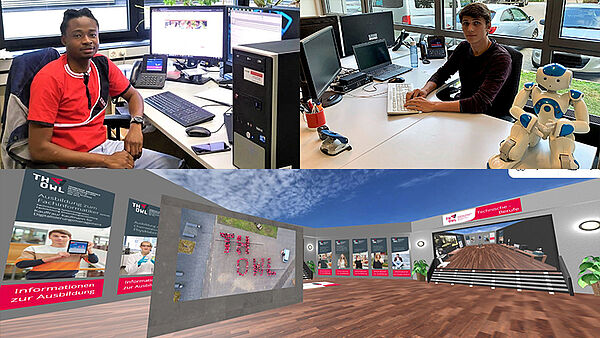The second nationwide Digitaltag 2021 took place on 18.06.21 under the motto: "Shaping digitization". The Ostwestfalen-Lippe University of Applied Sciences also participated and opened its university doors live and digitally. In several virtual rooms, the various departments, institutes as well as study, work and training opportunities were presented. In the run-up to the digital event, there were many technical and organizational tasks to prepare and implement. Tomke Dickewied and Pacome Ouedraogo, two trainees at TH OWL's Institute for Industrial Information Technology (inIT), took on some of them. In this interview, they talk about how their training as IT specialists for systems integration at inIT helped them realize the project.
You set up the virtual "training" room in Mozilla Hubs almost on your own. What did your day-to-day work look like and what specific tasks did you have?
Tomke: We designed three rooms around the theme of training. Together with our trainers and trainees, we collected ideas about what exactly should be presented there and then rebuilt the basic framework of the Mozilla Hub. Pacome and I divided up the tasks, worked with each other and implemented the 3D environment, for example. Specifically, for example, we used pre-generated objects to build the rooms, put in virtual walls, hung posters on the wall, inserted 3D objects, etc., just like an architecture program, so that it would later look like a room. It was a bit inconvenient that I always had to download or export the data for the rooms to send them to the other editor, who had to reinsert or import them into his own system and then send them back to me edited, but otherwise everything ran smoothly. The editing tool did not allow for several people to work on it at the same time.
Pacome: We first worked with a free version, then edited with another software (Blender) and then put this into Mozilla Hub. So we created objects and rooms, prepared proposals, and later incorporated the change requests of the professors and staff.
How did your previous knowledge from the training help you to implement the project?
Pacome: I had some previous experience with 3D software, but not with Mozilla Hub. A graphical understanding and knowledge are needed to create such spaces and to be able to use the software.
Tomke: For me these were completely new tasks, so I was happy that Pacome and Mr. Knehans from FB 5 had already worked with it. Apart from that, we had already done a bit of professional image editing in class, which also helped me.
How long did you work on the project?
Tomke & Pacome: We didn't count that exactly, about 3-4 weeks.
Did you face any technical challenges in creating the virtual environment in Mozilla Hub, and if so, what were they?
Tomke: We had initially planned just one large room with three continuing rooms, but then we had problems with memory capacity and had to split the virtual rooms to ensure better performance. But this still wasn't enough in some cases, so we had to downscale 3D objects, for example. We had some minor technical issues that we didn't know about yet, but then the challenge was to get into those issues. Working together on the rooms was also difficult, as I just mentioned, so we realized how important coordination is.
Pacome: Exactly. We also noticed that the working notebooks were reaching their limits in terms of computing power. A lot of data comes together during such a performance.
Are you satisfied with the result?
Tomke & Pacome: Yes. We got positive feedback and everyone was excited, so we are also happy that the work we put into the project is appreciated.
In retrospect, what went particularly well or poorly?
Tomke: Pacome and I have been working together for a long time and are well attuned. However, we have also discussed and exchanged ideas with the trainers, training managers and trainees in many rounds. We have become even closer during training and have had more contact with each other, so coordination has gone smoothly, ideas have been collected, and we have worked together. That was very nice and went particularly well.
Pacome: I think the creation of the virtual rooms went particularly well, everything was perfect.
What exciting projects do you have coming up next as part of your training?
Pacome: We've finished our training now and I'm continuing to work at inIT as an employee in Technology & Administration.
Tomke: I'm also continuing to work here part-time as an employee in technology and administration, and I'm also going to catch up on my vocational baccalaureate so that I can continue my studies afterwards. The implementation of the virtual rooms was therefore once again a nice project for the end of my training.
For more information about the digital open day of TH OWL, please visit www.th-owl.de/digitaltag.
.


